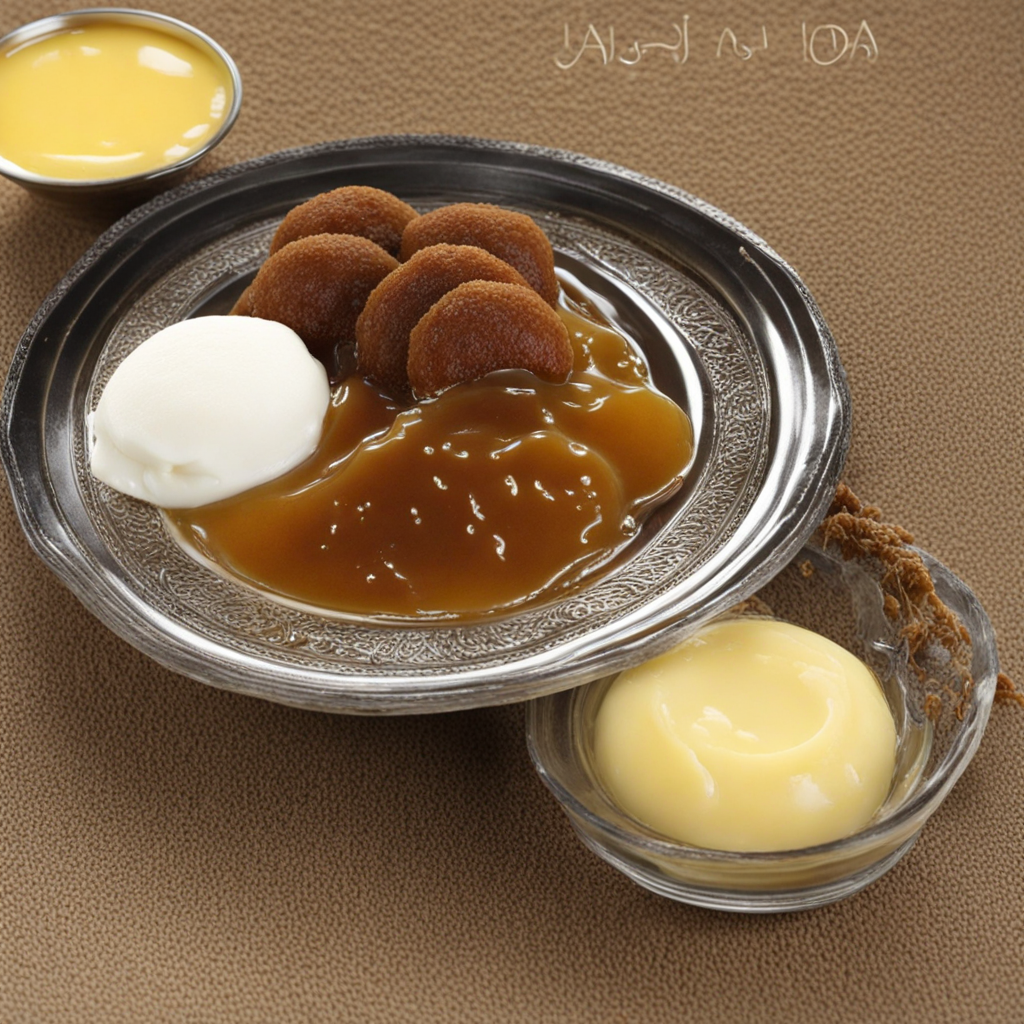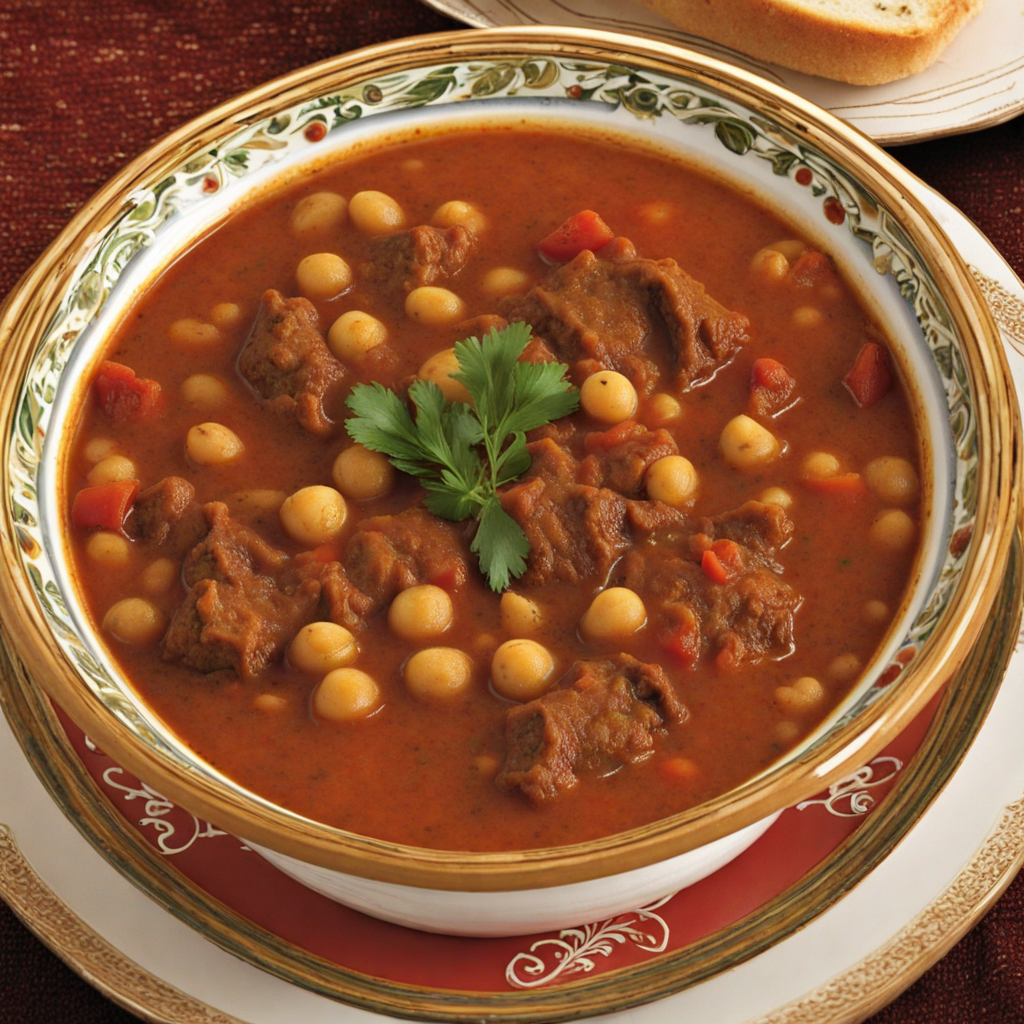Asida
Asida is a traditional Libyan dish that embodies the rich culinary heritage of North Africa. It is primarily made from flour, water, and a pinch of salt, resulting in a smooth, doughy consistency that is both hearty and comforting. The preparation involves cooking the flour in boiling water, stirring continuously until it reaches a thick, elastic texture. This simple yet versatile dish can be served with various accompaniments, making it a staple in many Libyan households, especially during special occasions and family gatherings. What sets Asida apart is its unique ability to absorb flavors from the ingredients with which it is paired. Typically, it is enjoyed with a drizzle of honey or syrup, which adds a delightful sweetness. Some variations include the addition of spices or herbs, enhancing its taste profile. Additionally, Asida can be served alongside savory stews or meat dishes, making it a perfect complement to the robust flavors of North African cuisine. The experience of eating Asida is not just about the taste; it is also about tradition and communal sharing. Often, it is presented on a large platter, where family and friends gather to enjoy the dish together, using their hands to scoop up portions. This communal aspect, along with its delightful texture and adaptability to different flavors, makes Asida a wonderful dish for anyone eager to explore the culinary treasures of Libya.
How It Became This Dish
The food known as عصيدة (asida) has deep roots in Libyan culture, where it serves not only as a staple dish but also as a symbol of hospitality and tradition. The origins of asida can be traced back to the Berber tribes of North Africa, who used simple ingredients to create nourishing meals. Traditionally, the dish is made from a mixture of wheat flour and water, which is stirred vigorously to create a smooth, thick paste. This method of preparation has been passed down through generations, showcasing the culinary techniques that have defined Libyan cooking. Asida is often associated with celebrations and communal gatherings, making it more than just a meal. In Libya, it is typically served during significant religious occasions, such as the celebration of Eid al-Adha, as well as during weddings and other festive events. The dish is often prepared in large quantities to accommodate family and friends, reflecting the Libyan ethos of sharing and generosity. It is common for families to gather around a communal bowl of asida, emphasizing the importance of togetherness in Libyan culture. The texture of asida is crucial to its appeal. The dish is usually smooth and creamy, achieved through careful stirring and cooking. Once cooked, it is often molded into a dome shape and served with various toppings, such as honey, olive oil, or a savory sauce made from meat or vegetables. These variations in toppings allow for creativity and personalization, enabling families to add their unique touch to the dish while still honoring tradition. The versatility of asida has allowed it to adapt to different tastes and preferences, making it a beloved dish across Libya. Over time, the preparation of asida has evolved, influenced by both local and external culinary practices. With the influx of different cultures and cuisines due to trade and migration, new ingredients have been introduced, enriching the traditional recipe. For example, the incorporation of spices such as cumin and coriander has become more common, giving the dish a unique flavor profile that reflects Libya's diverse culinary heritage. This evolution is a testament to the adaptability of asida, which continues to thrive amidst changing culinary landscapes. The cultural significance of asida extends beyond its role as a meal; it is also intertwined with various aspects of Libyan life. It is often used in rituals and ceremonies, marking important life events such as births, marriages, and funerals. The preparation of asida can also be seen as a form of cultural expression, where families pass down techniques and recipes to younger generations, ensuring that the tradition continues. This act of cooking together fosters family bonds and strengthens cultural identity, making asida a vital part of Libyan heritage. In rural areas of Libya, asida is often made in a traditional way, using a wooden spoon known as a مغرفة (maghfa) and a large pot over an open fire. This method not only enhances the flavor but also connects the cook to their ancestors, who relied on similar techniques. The communal aspect of preparing asida in these settings reinforces social ties and encourages the sharing of stories and experiences, making the cooking process as meaningful as the dish itself. In urban settings, while many still adhere to traditional methods, there has been a shift towards convenience. Ready-made mixes and instant versions of asida are now available in supermarkets, catering to the fast-paced lifestyle of modern Libyans. However, this shift does not diminish the love for homemade asida; many families still prioritize the traditional preparation of the dish during special occasions to maintain cultural integrity. This duality showcases the resilience of Libyan culinary traditions, balancing modernity with a respect for the past. Asida is also a reflection of Libya's agricultural practices, particularly concerning wheat cultivation. Wheat has been a staple crop in the region for centuries, and its importance is mirrored in the central role of asida in the Libyan diet. The agricultural landscape of Libya, with its varying climates and terrains, has shaped how asida is prepared and enjoyed. In areas where wheat is abundant, the dish is often a daily staple, while in regions with limited agricultural output, it may be reserved for special occasions. The dish has gained recognition beyond Libya's borders, particularly among the Libyan diaspora. Asida is often made in Libyan households around the world, acting as a culinary bridge that connects expatriates to their homeland. Through the preparation and sharing of asida, Libyan communities abroad maintain a sense of identity and belonging, reinforcing the idea that food is a powerful medium for cultural preservation. This transnational aspect of asida highlights its significance as a cultural artifact that transcends geographical boundaries. In recent years, there has been a resurgence of interest in traditional Libyan cuisine, with asida at the forefront of this movement. Chefs and home cooks alike are exploring historical recipes and techniques, often experimenting with local ingredients to create contemporary versions of asida. This trend reflects a broader global fascination with authentic, regional foods, as people seek to reconnect with their roots and explore culinary heritage. Asida has become a symbol of this culinary renaissance, representing not only the flavors of Libya but also the resilience and adaptability of its people. Through its rich history and cultural significance, asida embodies the essence of Libyan identity. It serves as a reminder of the importance of community, tradition, and the enduring nature of culinary practices. As Libya continues to navigate modern challenges, asida remains a cherished dish that brings people together, celebrating both the past and the present. Whether enjoyed in a bustling city or a quiet rural village, asida is a testament to the enduring power of food as a source of connection and cultural pride.
You may like
Discover local flavors from Libya







